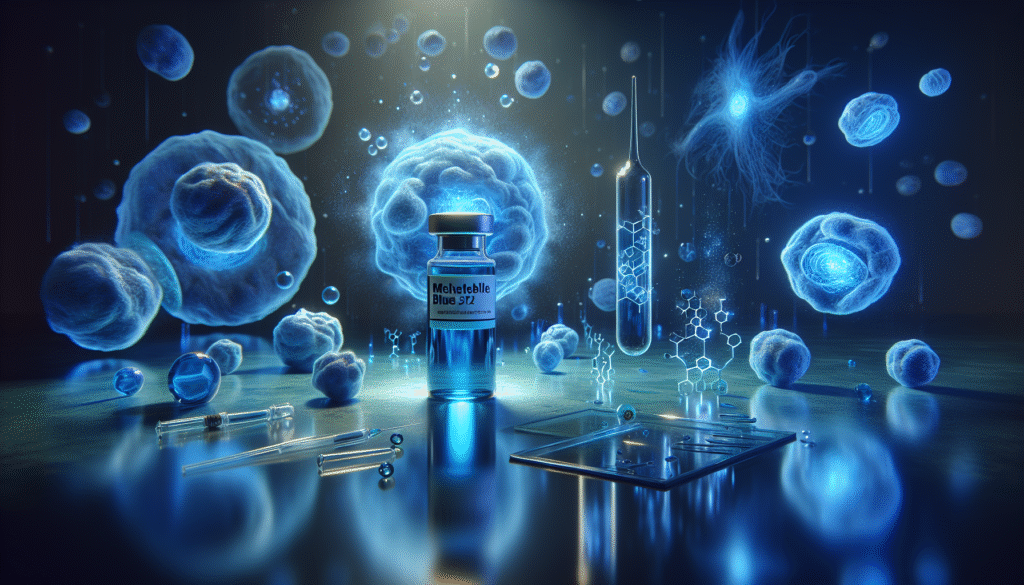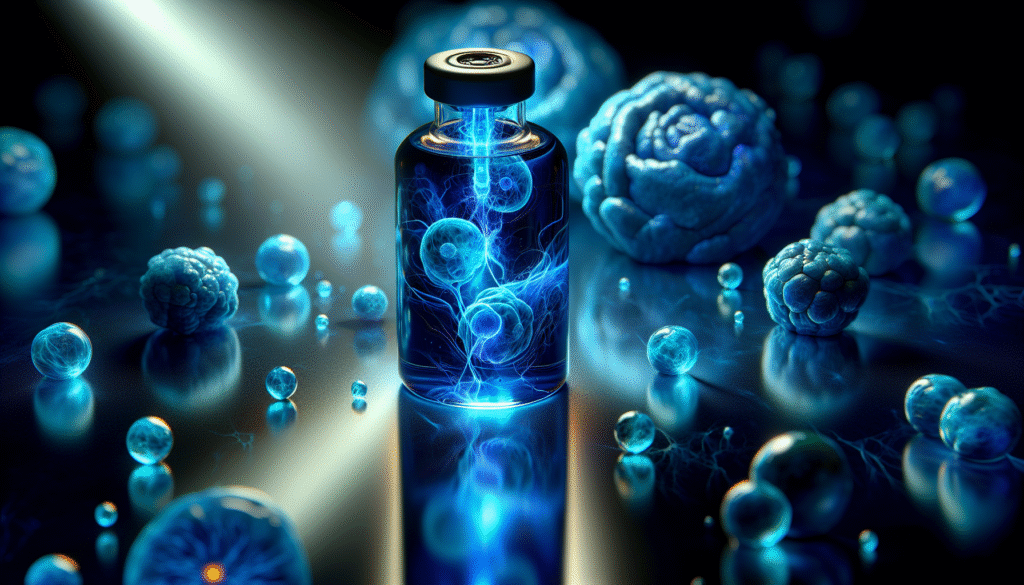
Have you ever considered how much your energy levels influence your daily life? Many factors contribute to feelings of fatigue, but did you know that the cellular mechanisms behind energy production can be significantly impacted by certain compounds? One such compound that has gained increasing attention in recent years is Methylene Blue.

Understanding Methylene Blue
Methylene Blue is a synthetic compound that has been used for various medical applications since the late 19th century. Originally employed as a dye, its versatility has allowed it to find roles in fields such as pharmacology, diagnostics, and even genetics. However, it’s Methylene Blue’s role in enhancing mitochondrial function and cellular energy production that is drawing interest in health and wellness circles.
The Chemical Structure of Methylene Blue
Methylene Blue, also known as thionin, features a complex molecular structure that plays a significant role in its function. Its chemical formula is C16H18ClN3S, and it has a vibrant blue color due to its specific absorption and reflection of light. This structure allows Methylene Blue to interact with various biological systems, making it a unique compound for research.
Cellular Energy Production: An Overview
To understand how Methylene Blue enhances cellular energy, it’s essential to grasp how energy is produced at the cellular level. The primary energy currency of cells is adenosine triphosphate (ATP), synthesized primarily in the mitochondria, the powerhouse of the cell.
The Process of Cellular Respiration
Cellular respiration involves several stages:
-
Glycolysis: The breakdown of glucose into pyruvate, yielding a small amount of ATP. This process occurs in the cytoplasm and does not require oxygen.
-
Krebs Cycle (Citric Acid Cycle): Pyruvate enters the mitochondria and undergoes further breakdown, generating electron carriers (NADH and FADH2) that contribute to the next stage.
-
Electron Transport Chain: This is where Methylene Blue becomes particularly significant. The electron transport chain uses the electrons from NADH and FADH2 to establish a proton gradient across the mitochondrial membrane, facilitating ATP production.
The Role of Methylene Blue in ATP Production
Research indicates that Methylene Blue can serve as an electron carrier in the electron transport chain, thus enhancing ATP production. This function can be particularly beneficial in situations where mitochondrial function is impaired.
Mechanisms of Action
Methylene Blue may improve cellular energy through several mechanisms:
-
Mitochondrial Function: By acting as an alternative electron carrier, Methylene Blue bypasses blocked or dysfunctional complexes in the electron transport chain.
-
Enhanced Oxygen Utilization: Methylene Blue assists in improving the oxygen utilization within the mitochondria, allowing for more efficient ATP production.
-
Reduction of Oxidative Stress: It also has antioxidant properties, helping to mitigate oxidative stress that can hinder cellular function and energy production.
Benefits of Enhanced Cellular Energy
Greater cellular energy can translate into numerous benefits in your daily life. Improved ATP production enhances not only physical performance but also cognitive function, emotional well-being, and overall vitality.
Physical Performance
Increased energy at the cellular level can lead to better endurance and strength. Whether you are an athlete seeking to improve performance or an individual looking for increased vitality in everyday tasks, enhancing energy production can make a significant difference.
Cognitive Function
Energy is crucial for optimal brain function. Mitochondria in brain cells are highly sensitive to energy fluctuations. By enhancing mitochondrial function through Methylene Blue, you may experience improved focus, memory retention, and mental clarity.
Emotional Well-Being
Fatigue and low energy levels can have a profound impact on your mood. By facilitating better energy production, Methylene Blue can potentially alleviate feelings of depression and anxiety associated with low energy states.

Safety and Dosage of Methylene Blue
While Methylene Blue has several promising applications, it is essential to approach its usage with caution. Understanding the appropriate dosages and potential side effects is crucial for ensuring safety.
Recommended Dosage
The appropriate dosage of Methylene Blue can vary based on individual factors. Albeit there is no universal guideline, research suggests that doses ranging from 0.5 mg/kg to 4 mg/kg body weight may be effective for enhancing mitochondrial function. It is strongly advised to consult with a healthcare professional before commencing any supplementation.
Potential Side Effects
When taken as directed, Methylene Blue is generally safe; however, there are some possible side effects to be aware of:
-
Gastrointestinal Distress: Some individuals may experience nausea, vomiting, or diarrhea.
-
Urine Discoloration: A harmless side effect is the temporary blue-green coloration of urine due to the excretion of Methylene Blue.
-
Interference with Certain Medications: Methylene Blue can interact with various medications, particularly those affecting serotonin levels, resulting in potentially severe side effects like serotonin syndrome.
Methylene Blue and Specific Health Conditions
Research is beginning to unveil the potential benefits of Methylene Blue in various health conditions characterized by mitochondrial dysfunction or impaired cellular energy production.
Neurodegenerative Diseases
Mitochondrial dysfunction has been implicated in the progression of neurodegenerative diseases such as Alzheimer’s and Parkinson’s. Methylene Blue’s ability to enhance mitochondrial function could offer new therapeutic avenues for individuals suffering from these conditions.
Metabolic Disorders
Conditions like diabetes are associated with compromised mitochondrial function and insulin resistance. Preliminary studies suggest that Methylene Blue may assist in improving insulin sensitivity and modulating metabolic processes.
Age-Related Decline
As individuals age, mitochondrial function tends to decline, leading to decreased energy levels and increased fatigue. Some research indicates that Methylene Blue may help counteract these effects, promoting better energy production and overall vitality.
Ways to Incorporate Methylene Blue into Your Routine
If you are considering adding Methylene Blue to your wellness regimen, there are various forms and methods of administration to consider.
Supplementation
Methylene Blue is available in several supplement forms, including capsules, tablets, and liquid solutions. Selecting a high-quality product from a reputable manufacturer is crucial.
Intravenous Administration
In clinical settings, Methylene Blue can be administered intravenously, particularly in cases that require immediate effects or higher dosages. This method is typically reserved for medical professionals due to the need for careful dosage management.
Conclusion: Is Methylene Blue Right for You?
As you contemplate your energy levels and the potential benefits of Methylene Blue, it is essential to consider both the advantages and the risks associated with its use. Understanding how Methylene Blue works can position you to make informed decisions about your health.
While promising research supports Methylene Blue’s ability to enhance cellular energy, individual responses can vary greatly. Engaging with healthcare professionals familiar with your medical history and current health status can help determine whether incorporating Methylene Blue is a wise choice for you.
As you navigate your path toward improved energy and wellness, remember that maintaining a balanced lifestyle—encompassing proper nutrition, exercise, and mental well-being—is equally vital for fostering optimal cellular energy and overall health.